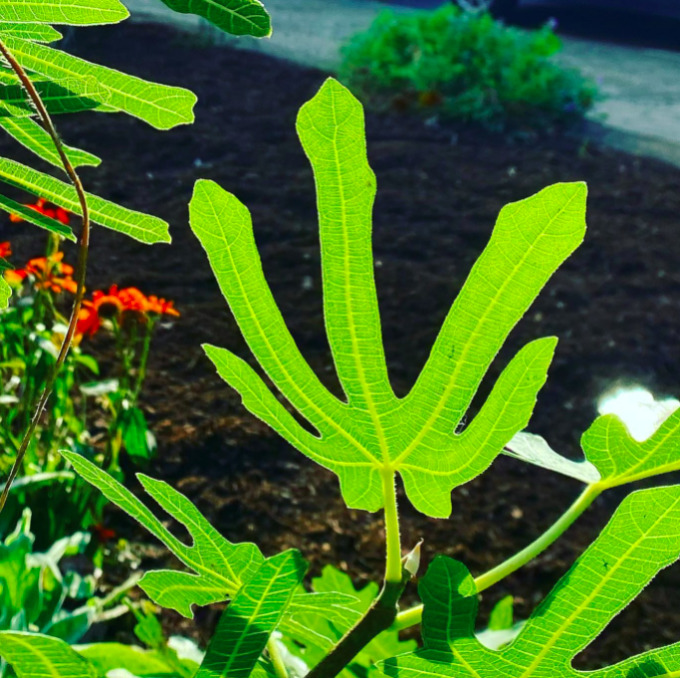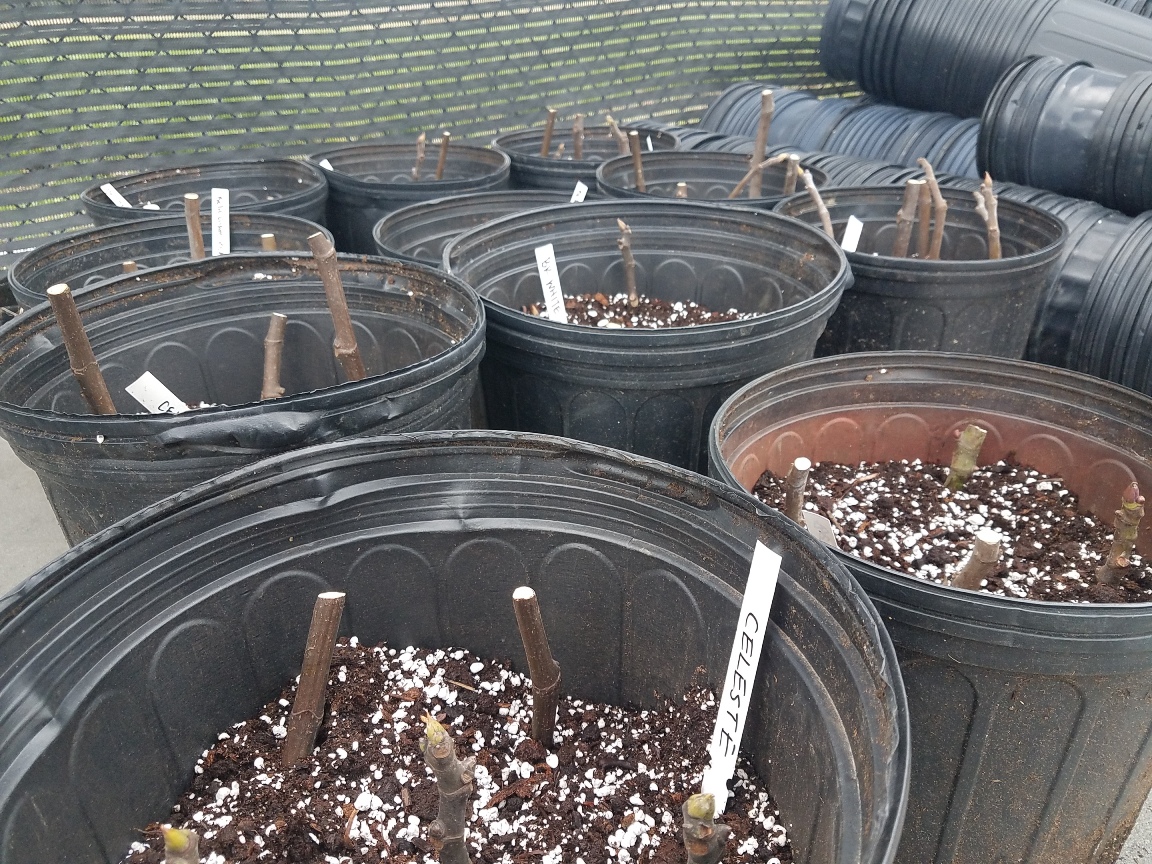by Anisa George
Figs have been with us from the beginning. You’ve probably seen one or two pictures of Adam and Eve being booted out of paradise, sporting some fig-leaf bikinis. Creative license on the part of the artist, of course, but modern archeologists do point to evidence that figs may have been one of the first crops human beings ever propagated (sorry wheat).
A lot of the old fig trees in South Philadelphia, where I live, were smuggled here by Italian-American immigrants. Old-timers will talk about their grandmothers and grandfathers sneaking in saplings. An Inquirer article from 1991 tells the story of one that was hid inside a folded umbrella and mulched with scraps of leather from a shoe shop. My neighbor, Peter Verrecchia (so Italian) is one of the most notorious fig propagators in the city. His bike is rigged with a front loader for a five gallon tank of water, so he can revolve around the neighborhood watering all his trees. He’s a renegade—an unusual amalgam of community organizer and saboteur.
“I have a bullseye on my back as far as Parks & Rec are concerned,” he tells me. Peter is especially partial to a variety of fig his grandmother passed down to him. He knows he’s put his trees in locations where they will never get enough sun to fruit, but tells me—“I’m in it for the leaves,” which happen to be deep lobed and to look much like a green version of the hand that tends them. You, however, may be in it for the figs—in which case there is more to think about when it comes to tending them.

To Wrap or Not to Wrap
Italian figs didn’t evolve to survive Philadelphia in the wintertime. The heat island effect somewhat buffers them against the coldest weeks, but many fig lovers insist on wrapping their trees every year to protect them from the killing frosts. You may have passed one yourself, looking like a plastic Frankenstein waiting for the bus. If you hate plastic, you can build a wire enclosure and stuff it with leaves instead.
Peter never wraps his figs, though. I stopped wrapping mine once they were in their third year, but if you have a more sensitive variety you may want to add this task to your annual list of chores. ‘Hardy Chicago’ is a cold tolerant variety if you’re looking for something with a better chance of staying alive. It also grows well in a pot, which can be dragged in and out of doors when the temperature dictates. Wrapping is sometimes easier than dragging (depending on your back).
Read more about POP’s recommendations for growing figs in cold climates here and some of our favorite fig varieties here.
Pruning
Fig trees are incredibly resilient, so if you find yourself with a lopper in hand worrying about whether or not you might kill the tree, rest assured—you probably won’t. I’ve seen fig trees, who’ve been cut down to a nub every year, resurrect themselves resolutely each spring. They almost seem to enjoy a good maiming.
Given the confines of my community garden, I’m usually pruning for size. A fig tree can easily grow six feet in one year, and that quickly begins to block pathways and piss off the wheelbarrow pushers. So in the dormant season Peter cuts our figs down to a few main stems. He usually takes them back to about six feet. Some people go down to four feet. How low can you go? This kind of pruning looks brutal, but again, the fig seems to find a good hack job invigorating. It also makes the tree easier to wrap—if you’re into that sort of thing.
There are two kinds of fig harvests—the main crop and the secondary crop, which is known as the breba crop (from breva, the Spanish word for fig.) The breba crop generally grows on one year-old wood and the main crop on new wood, though some trees don’t grow any breba at all. Generally the breba crop is not as tasty as the main crop and only fruits after mild winters, so I don’t prune for it. If you want to cultivate your breba you need to leave some year-old stems on your trees. I slice them off and direct all the tree’s juju to the main crop instead. Because the main crop of figs is produced on new growth, aggressive pruning can actually result in more new growth and therefore more fruit production. However, it can also delay the onset of fruit, which may result in a lack of ripe figs in slower-producing cultivars.

Pollination:
We don’t need to worry about pollinating figs in Philadelphia because all of the varieties we grow in this region are of the Common Fig species (Ficus carica), which is parthenocarpic—meaning they are able to produce fruit without being pollinated. Nevertheless, I’d like to write a word on the subject, because it’s friggin’ fascinating. Basically almost all of the world’s eight hundred and seventy-five species of Ficus have their own unique fertilizing wasp.
To anyone who insists on preaching a dog-eat-dog world, the co-evolution of figs and wasps is, in contrast, a resounding testimony to a collaborative one. The tiny fig wasp slips inside the eye at the bottom of its specially tailored fruit to lay its eggs. Botanically speaking, the fig is not a fruit at all, but an inflorescence—an inverted flower. The ovulating wasp enters this hollow garden of flowers to lay her eggs, pollinating the incubating fig in the process. When the young wasps emerge from their galls they carry pollen from their birthing fig towards a new immature fig, completing the pollination process. The female wasp sheds her wings as she squeezes into the next fig chamber—a sacrifice that completes a cycle of mutual benefit which has been repeating itself for millions of years. This of course raises the question, “When I’m eating figs, am I eating wasps?” The truth is, you may never know. Many commercial species of figs have been cultivated to self-pollinate. Figs also produce an enzyme called ‘ficin’ that breaks down and digests the body of the wasp until it disappears. Basically, don’t worry about the crunch. It’s made by seeds not bodies.
Harvesting
In Philadelphia, main crop figs generally ripen from August through October. They’re incredibly versatile and can be eaten raw, dried, cooked, grilled, pickled, or turned into jam. The leaves also make a delicious and nutritious tea which may aid in lowering blood sugar and combating diabetes.

Propagation
If you have a fig tree that’s bringing you joy, think about helping it to have babies. It’s super easy. Peter likes to propagate his figs through ground layering which means burying an attached branch of the living tree in soil until it roots. The rooting branch can then be cut into fragments and potted up to produce new, independent fig trees. You can also use other kinds of layering or simply cut off a tipped stem, remove all the leaves, scrape off the bottom two inches of bark, and stick it into some soil. It will eventually grow roots and turn into a mature tree. Fig cuttings root very easily and rooting hormone isn’t needed; hardwood cuttings have the best success rate, but softwood cuttings can also work. More figs in the world is basically one step closer to a world that is paradise. We’ll get back there eventually.
This blog post contributed by POP Volunteer Anisa George.
More Info
Growing Figs in Cold Climates by Lee Reich
SUPPORT US! If you found this entry useful, informative, or inspiring, please consider a donation of any size to help POP in planting and supporting community orchards in Philadelphia: phillyorchards.org/donate.